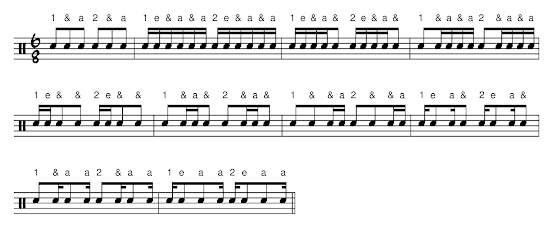Basically, in any compound meter— 6/8, 12/8, 3/8, 9/8, 15/8— when 16th notes are involved, count 1e&a&a, instead of the 1&a we (I) use with 8th notes.
Here, count through some basic rhythms that way, and see how it goes:
It works. It's easy to say it fast, and that repeated & syllable gives each beat of 16th notes a little waltz feel. The only part that doesn't flow easily is the 1e a& rhythm— in isolation the a& part requires a little extra articulation with your voice.
It works. It's easy to say it fast, and that repeated & syllable gives each beat of 16th notes a little waltz feel. The only part that doesn't flow easily is the 1e a& rhythm— in isolation the a& part requires a little extra articulation with your voice.
Sidebar for quibblers: Yes, the a partial, when we're counting 8th notes, becomes a second & when there are any 16ths involved. It's different! Not only is that, we've added two more as on the last two off-side 16th notes!
What can I say, the world's an imperfect place. I'm prioritizing ease of speaking over consistent or unique syllables with this one. The only reason you need unique syllables is so you can refer to parts of a rhythm easily, e.g. your timing is off on the a of 2 there. So now you say your timing is off on the second a of 2 there instead.
It has been extremely helpful for odd meters, too. The difference between having a good system and a weak system, or no system, is huge. Here are some basic rhythms in 5/8, counted as a lopsided 2:
I like it. Before, if I needed to count out this type of rhythm for a student, I had to do it very laboriously in the top number of the time signature— counting in 6 or 12 or whatever— 1&2&3&4&5&6&— which is hard to do at tempo, and is also just not how we count these time signatures. More often I would sing the rhythm, which is OK, but the numbers and other syllables give us a little more to hold onto.



No comments:
Post a Comment